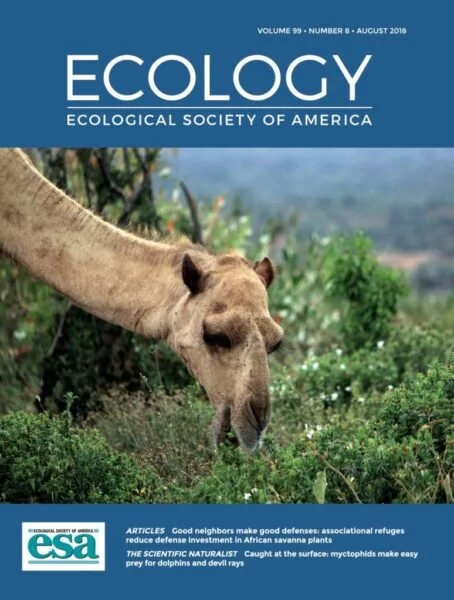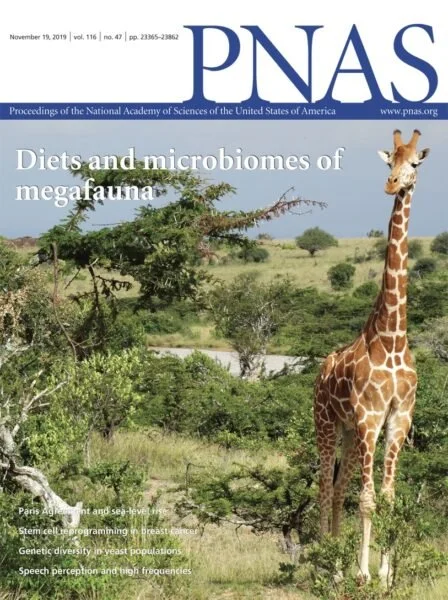explore our
Publications
Disturbances in drylands: interactions among herbivory, drought, and termite activity in savanna plant communities
HBM Wells, Kimuyu DM, Odadi WO, Charles GK, Veblen KE, Porensky LM, Riginos C, Ekadeli J, Namoni M, Ekeno J, Kimiti B, Kurukura B, Hassan AA, Hallett LM, Wolf AA, Pringle RM, and Young TP. 2025. Journal of Ecology 00:1–13.
Water economics of African savanna herbivores: how much does plant moisture matter?
JA Van Driessche, Chamaillé-Jammes S, Nutter CM, Potter AB, Pringle RM, and Long RA. 2025. Journal of Animal Ecology 94:670–681.
Spatiotemporal variation in the gut microbiomes of co-occurring wild rodent species
BRP Brown, Khasoha LM, Lokeny P, Jakopak RP, Reed CG, Dyck M, Wambua A, Newsome SD, Palmer TM, and Pringle RM. 2024. Ecosphere 15(5): e4854.
Interplay of competition and facilitation in grazing succession by migrant Serengeti herbivores
TM Anderson, Hepler SA, Holdo RM, Donaldson JE, Erhardt RJ, Hopcraft JGC, Hutchinson MC, Huebner SE, Morrison TA, Muday J, Munuo IN, Palmer MS, Pansu J, Pringle RM, Sketch R, and Packer C. 2024. Science 6684:782–788.
Herbivore regulation of savanna vegetation: structural complexity, diversity, and the complexity–diversity relationship
TC Coverdale, Boucher PB, Singh J, Palmer TM, Goheen JR, Pringle RM, and Davies AB. 2024. Ecological Monographs 94(4): e1624.
The development of ecological systems along paths of least resistance
J Deng, Cordero OX, Fukami T, Levin SA, Pringle RM, Solé R, and Saavedra S. 2024. Current Biology 20:4813–4823.
Determinants of microbiome composition: insights from free-ranging hybrid zebras (Equus quagga × grevyi)
JO Abraham, Lin B, Miller AE, Henry LP, Demmel MY, Warungu R, Mwangi M, Lobura PM, Pallares LF, Ayroles JF, Pringle RM, Rubenstein DI. 2024. Molecular Ecology 33:e17370.
Grazing herbivores reduce herbaceous biomass and fire activity across African savannas
AT Karp, Koerner SE, Hempson GP, Abraham JO, Anderson TM, Bond WJ, Burkepile DE, Fillion EN, Goheen JR, Guyton JA, Kartzinel TR, Kimuyu DM, Mohanbabu N, Palmer TM, Porensky LM, Pringle RM, Ritchie ME, Smith MD, Thompson DI, Young TP, and Staver AC. 2024. Ecology Letters 27:e14450.
Wild herbivores enhance resistance to invasion by exotic cacti in an African savanna
HBM Wells, Crego RD, Alston JM, Ndung'u SK, Khasoha LM, Reed CG, Hassan AA, Kurukura S, Ekadeli J, Namoni M, Peter S Stewart, Duncan M Kimuyu, Amelia A Wolf, Truman P Young, Tyler R Kartzinel, Todd M Palmer, Jacob R Goheen, and Pringle RM. 2023. Journal of Ecology 1:33–44.
Ecology: how mesopredators run with the big dogs
EM Phillips and Pringle RM. 2023. Current Biology 33(5):R197-R199.





















